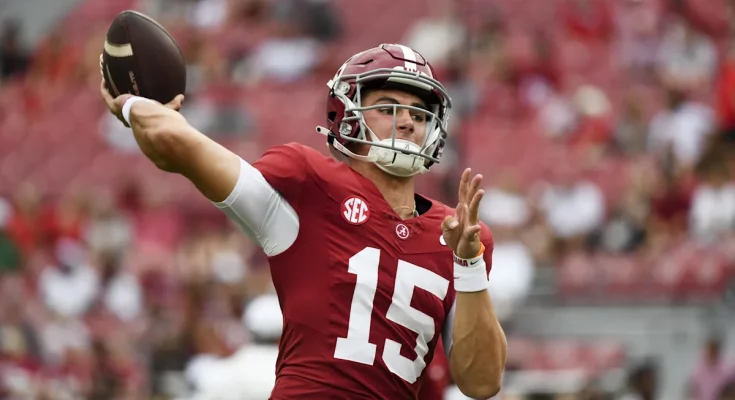Alabama football has always been a program defined by its excellence at the quarterback position, and this year is no different as the Crimson Tide navigate another high-stakes season with a heated competition under center. Following a recent scrimmage, former Alabama quarterback and current analyst Greg McElroy shared his assessment of the signal-callers vying for the starting job, offering insight into their strengths, weaknesses, and how they might fit into the team’s offensive scheme. His observations provide a glimpse into what fans can expect as the season approaches, with each quarterback bringing a unique skill set to the table.
One of the most talked-about players in the competition is Jalen Milroe, a dual-threat quarterback who saw limited action last season but has shown flashes of brilliance in both his arm talent and athleticism. McElroy noted that Milroe has made significant strides in his passing accuracy and decision-making, two areas that were occasionally inconsistent in his previous appearances. His ability to extend plays with his legs adds a dynamic element to the offense, forcing defenses to account for his mobility. However, McElroy pointed out that Milroe must continue refining his pocket presence and ability to read complex coverages, as Alabama’s offense often requires quick, precise throws against elite SEC defenses.
Another contender in the mix is Ty Simpson, a highly touted recruit who has been patiently waiting for his opportunity to lead the Tide. McElroy praised Simpson’s natural throwing ability, highlighting his smooth mechanics and arm strength, which allow him to make all the necessary throws at the college level. Simpson’s understanding of the playbook and ability to process defenses quickly stood out during the scrimmage, suggesting that he could be a reliable option if the coaching staff prioritizes a traditional, pro-style passer. However, McElroy also mentioned that Simpson lacks the same level of explosiveness as Milroe in the running game, which could be a factor in how offensive coordinator Tommy Rees structures the offense.
The wildcard in the competition is Tyler Buchner, the Notre Dame transfer who followed Rees to Tuscaloosa. Buchner’s familiarity with the system gives him an immediate advantage, and McElroy observed that he looked comfortable executing the offense during the scrimmage. His experience in live game action, including starts for the Fighting Irish, could prove valuable in a high-pressure environment. That said, Buchner has had issues with turnovers in the past, and McElroy emphasized that ball security will be critical if he hopes to win the job. His athleticism is solid, though not quite as electric as Milroe’s, making him more of a balanced threat rather than a true dual-threat quarterback.
McElroy also touched on the broader implications of the quarterback battle, noting that the decision will ultimately come down to what head coach Nick Saban and his staff believe gives the team the best chance to win. Alabama’s offense has evolved over the years, from a run-heavy approach with game managers like Greg McElroy himself to high-flying attacks led by Bryce Young. The identity of this year’s team could hinge on which quarterback earns the starting nod. If Milroe wins the job, the offense may incorporate more designed quarterback runs and play-action passes off of his mobility. If Simpson emerges as the starter, Alabama could lean into a more methodical, drop-back passing attack. And if Buchner takes the reins, the offense might strike a balance between the two, utilizing his experience in Rees’ system to keep defenses guessing.
One of the key takeaways from McElroy’s assessment was the importance of consistency. While all three quarterbacks have shown the ability to make spectacular plays, the winner of the job will likely be the one who can avoid costly mistakes and sustain drives against top-tier competition. Alabama’s defense is expected to be among the nation’s best once again, meaning the offense won’t need to score 40 points every game to win. However, in critical matchups against teams like Georgia, LSU, or Tennessee, the quarterback must be able to deliver under pressure. McElroy recalled his own time at Alabama, where managing the game and minimizing errors were just as important as making big throws.
Another factor that could influence the decision is leadership. The starting quarterback at Alabama isn’t just a player—he’s the face of the program, responsible for rallying the team in tough moments. McElroy noted that all three candidates have shown leadership qualities, but the intangibles—such as command of the huddle, poise in adversity, and the ability to elevate teammates—will play a major role in Saban’s final decision. The locker room’s trust in the quarterback is something that can’t be measured in stats alone, and the coaching staff will be closely evaluating how each player handles the responsibility that comes with the position.
As the season draws nearer, the competition will only intensify. McElroy suggested that the coaching staff may not name a starter until late in fall camp, preferring to let the battle play out as long as possible to ensure the best player emerges. It’s also possible that Alabama could use multiple quarterbacks early in the season, allowing each to prove themselves in live game action before committing to a full-time starter. This approach isn’t uncommon, especially when the margin between players is slim, and it could provide valuable clarity before the Tide enter the heart of their SEC schedule.
For fans, the quarterback battle is both exciting and nerve-wracking. On one hand, having multiple talented options is a luxury that most programs don’t enjoy. On the other, the uncertainty can create anxiety, especially when the standard at Alabama is national championship or bust. McElroy’s assessment provides reassurance that, regardless of who wins the job, the Crimson Tide will have a capable leader under center. The key will be ensuring that the offense is tailored to that quarterback’s strengths, allowing him to play confidently and efficiently.
In the end, Alabama’s success this season won’t rest solely on the quarterback’s shoulders. The offensive line must provide protection, the running game needs to establish balance, and the defense will have to dominate as expected. But as history has shown, the quarterback is often the difference between a good season and a great one. McElroy’s insights offer a valuable perspective on where things stand today, but the true test will come when the lights are brightest and the stakes are highest. One thing is certain: all eyes will be on Alabama’s quarterbacks as they look to uphold the program’s championship tradition.



